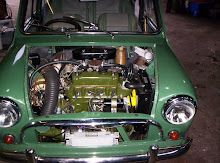When a normal synchromesh gearbox is fitted, the timing marks on the rim of the flywheel can be inspected by removing the cover on the clutch housing shown in Fig. 40. A mirror and an inspection light will probably be needed. Top-dead-centre is indicated by a line and the figures 1/4.- To the left of the T.D.C. line are further marks showing 5°, 10° and, in some cases, 15r before top-dead-centre.
On automatic-transmission models there is a large rubber grommet on the top of the converter cover and a small grommet in the converter housing (see Fig. 41). Three marks are visible on the flywheel rim when the large grommet has been removed—1/4, which is top-dead-centre, and 5° and 10° before top-dead-centre.
The engine can be rotated to bring the correct mark (see page 144) into line with the pointer by levering on the starter ring gear with the tip of a screwdriver, passed through the opening which is closed by the smaller grommet. It is not possible to rotate the flywheel by engaging top gear and pushing the car backwards or forwards, as can be done when a synchromesh transmission is fitted, owing to the slip in the hydraulic torque converter when it is turning at low speeds.
Timing indicator on an automatic-transmission model. Inset, the aperture above the flywheel ring gear—see text
Never set the timing immediately after turning the engine backwards: the backlash in the timing chain and distributor driving gears will cause an appreciable error. Always turn the flywheel anti-clockwise (as seen through the inspection opening) when making the final adjustment. The services of an assistant make the job easier but it can be done single-handed.
If the distributor has been removed from the engine, slacken the clamp on the retaining plate and rotate the spindle until the rotor is pointing in the direction of the electrode in the cap that is connected to No. 1 sparking plug. The offset coupling on the distributor shaft should then engage with the corresponding drive in the crankcase when the distributor is slid into place. Check that it is fully home before tightening the securing setscrews.
The vacuum timing-control should be towards the clutch housing with the diaphragm housing upwards and nearly horizontal. Make sure that the centrifugal advance weights are not binding and that the contact-breaker baseplate is free to rotate slightly. Set the micrometer control so that about four divisions of the scale are visible.
The timing can now be set by rotating the distributor body anti-clockwise until the contact points are just closed and then slowly clockwise until they just separate. If the ignition is switched on, a small spark can be seen and heard to jump across the points as they separate. A more accurate method of timing is to connect a side-lamp bulb, mounted in a suitable holder, across the two low-tension terminals at the top of the ignition coil. When the points are closed the lamp will light up; at the instant that they open, it will be extinguished. When checking the opening point, keep a light finger pressure on the rotor in a clockwise direction to take up backlash in the drive.


0 comments:
Post a Comment